96 Percent of Businesses Can’t Be Wrong: How Hybrid Cloud Came to Dominate the Data Sector
Cloudera
JANUARY 26, 2022
Network operating systems let computers communicate with each other; and data storage grew—a 5MB hard drive was considered limitless in 1983 (when compared to a magnetic drum with memory capacity of 10 kB from the 1960s). The amount of data being collected grew, and the first data warehouses were developed.















Let's personalize your content